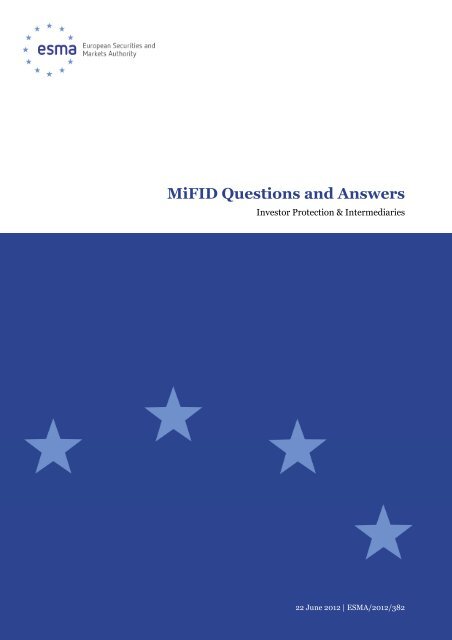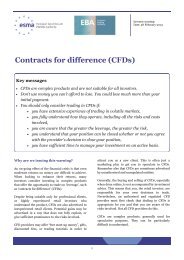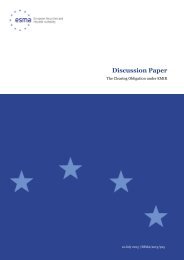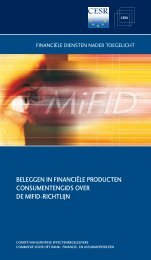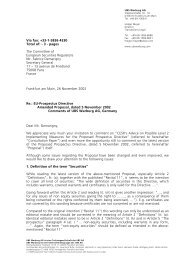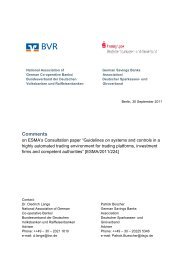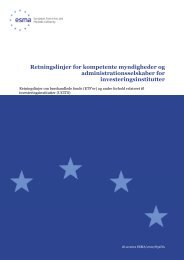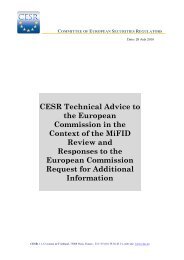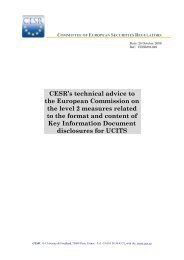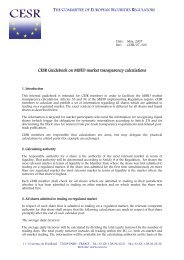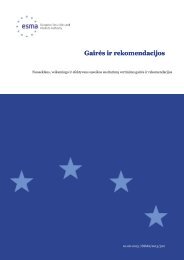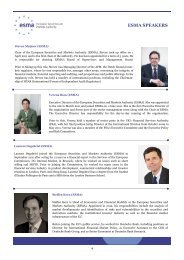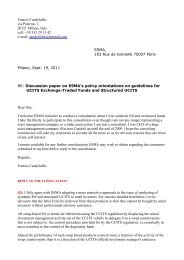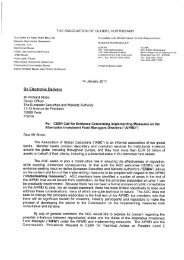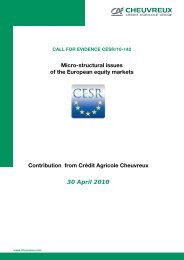MiFID Questions and Answers - Esma - Europa
MiFID Questions and Answers - Esma - Europa
MiFID Questions and Answers - Esma - Europa
Create successful ePaper yourself
Turn your PDF publications into a flip-book with our unique Google optimized e-Paper software.
<strong>MiFID</strong> <strong>Questions</strong> <strong>and</strong> <strong>Answers</strong><br />
Investor Protection & Intermediaries<br />
22 June 2012 | ESMA/2012/382
Contents<br />
Question 1: Article 19(4) of <strong>MiFID</strong> - Client profile review _________________________________ 5<br />
Question 2: Article 19(5) of <strong>MiFID</strong> - Appropriateness ___________________________________ 5<br />
Question 3: Articles 48 <strong>and</strong> 49 of the <strong>MiFID</strong> Implementing Directive - Aggregated orders <strong>and</strong> trade<br />
allocations ________________________________________________________________ 6<br />
Question 4: Article 32(2) of <strong>MiFID</strong> - Tied agents _______________________________________ 7<br />
Question 5: Article 41(3)(c) of the <strong>MiFID</strong> Implementing Directive - Leveraged portfolio ____________ 9<br />
Question 6: Articles 17(1) <strong>and</strong> 18(3) of the <strong>MiFID</strong> Implementing Directive - Due diligence on subcustodians<br />
________________________________________________________________ 11<br />
Question 7: Article 23 of <strong>MiFID</strong> - Tied agents_________________________________________ 12<br />
Question 8: Article 4(1)(4) of <strong>MiFID</strong>, <strong>and</strong> Article 24(1) of the <strong>MiFID</strong> Implementing Directive - Investment<br />
advice <strong>and</strong> investment research __________________________________________________ 13<br />
Question 9: Article 4(1)(9) of <strong>MiFID</strong> - Automatic execution of trade signals ____________________ 15<br />
ESMA • 103 Rue de Grenelle • 75007 Paris • France • Tel. +33 (0) 1 58 36 43 21 • www.esma.europa.eu<br />
Date: 22 June 2012<br />
ESMA/2012/382
I. Background<br />
1. The Markets in Financial Instruments Directive (<strong>MiFID</strong>) 1 is designed to help integrate Europe’s financial<br />
markets <strong>and</strong> to establish a common regulatory framework for Europe’s securities markets. It does<br />
this by allowing regulated markets, multilateral trading facilities (MTFs) <strong>and</strong> investment firms to operate<br />
throughout the EU on the basis of authorisation in their home Member State (the ‘single passport’).<br />
<strong>MiFID</strong> also introduced new <strong>and</strong> more extensive requirements for firms, in particular for their conduct<br />
of business <strong>and</strong> internal organisation. One of the main purposes of <strong>MiFID</strong> is to harmonise investor protection<br />
<strong>and</strong> market transparency throughout Europe.<br />
2. <strong>MiFID</strong> is made up of the following European legislation:<br />
a. Directive 2004/39/EC, which was adopted in April 2004. It is a ‘framework’ Level 1 Directive<br />
which has been supplemented by technical implementing measures (see the Level<br />
2 legislation in b. below).<br />
b. Implementing Directive 2006/73/EC 2 <strong>and</strong> Implementing Regulation 1287/2006 3 (the<br />
Level 2 legislation).<br />
3. ESMA’s predecessor (CESR) produced a series of questions <strong>and</strong> answers (Q&A) based on questions<br />
received through CESR’s <strong>MiFID</strong> Q&A mechanism. The Q&As reflected common positions agreed by<br />
CESR Members. They were one of the tools used by CESR to elaborate on the provisions of certain EU<br />
legislation, thereby fostering supervisory convergence.<br />
4. Similarly, ESMA is required to play an active role in building a common supervisory culture by promoting<br />
common supervisory approaches <strong>and</strong> practices. In this regard, ESMA will continue to develop<br />
Q&As as <strong>and</strong> when appropriate.<br />
II. Purpose<br />
5. The purpose of this document is to promote common supervisory approaches <strong>and</strong> practices in the<br />
application of <strong>MiFID</strong> <strong>and</strong> its implementing measures. It does this by providing responses to questions<br />
posed by the general public <strong>and</strong> competent authorities in relation to the practical application of <strong>MiFID</strong>.<br />
6. The content of this document is aimed at competent authorities under <strong>MiFID</strong> to ensure that in their<br />
supervisory activities their actions are converging along the lines of the responses adopted by CESR,<br />
<strong>and</strong> now ESMA. However, the answers are also intended to help firms by providing clarity as to the<br />
content of the <strong>MiFID</strong> rules, rather than creating an extra layer of requirements.<br />
1 Directive 2004/39/EC of the European Parliament <strong>and</strong> of the Council of 21 April 2004 on markets in financial instruments,<br />
30.4.2004, OJ L 145/1.<br />
2 Commission Directive 2006/73/EC of 10 August 2006 implementing Directive 2004/39/EC of the European Parliament <strong>and</strong> of the<br />
Council regarding organisational requirements <strong>and</strong> operating conditions for investment firms <strong>and</strong> defined terms for the purpose of<br />
that Directive, 2.9.2006, OJ L 241/1.<br />
3 Commission Regulation (EC) No 1287/2006 of 10 August 2006 implementing Directive 2004/39/EC of the European Parliament<br />
<strong>and</strong> of the Council as regards record-keeping obligations for investment firms, transaction reporting, market transparency, admission<br />
of financial instruments to trading, <strong>and</strong> defined terms for the purpose of that Directive, 2.9.2006, OJ L 241/1.<br />
3
III. Status<br />
7. The Q&A mechanism is a practical convergence tool used to promote common supervisory approaches<br />
<strong>and</strong> practices under Article 29(2) of the ESMA Regulation. 4<br />
8. Therefore, due to the nature of Q&As, formal consultation on the draft answers is considered unnecessary.<br />
However, even if they are not formally consulted on, ESMA may check them with representatives<br />
of ESMA’s Securities <strong>and</strong> Markets Stakeholder Group, the relevant St<strong>and</strong>ing Committees’ Consultative<br />
Working Group or, where specific expertise is needed, with other external parties.<br />
9. ESMA will review these questions <strong>and</strong> answers to identify if, in a certain area, there is a need to convert<br />
some of the material into ESMA guidelines <strong>and</strong> recommendations. In such cases, ESMA Regulation Article<br />
16 procedures will be followed.<br />
IV. <strong>Questions</strong> <strong>and</strong> answers<br />
10. CESR published its first <strong>MiFID</strong> Q&As in April 2008 <strong>and</strong> last updated them in May 2010. This document<br />
endorses the Q&As previously adopted by CESR 5 , as amended, <strong>and</strong> is intended to be continually<br />
edited <strong>and</strong> updated as <strong>and</strong> when new questions are received. The date each question was last amended<br />
is included after each question for ease of reference.<br />
11. <strong>Questions</strong> on the practical application of any of the <strong>MiFID</strong> requirements may be sent to the following<br />
email address at ESMA mifid@esma.europa.eu.<br />
4 Regulation (EU) No 1095/2010 of the European Parliament <strong>and</strong> of the Council of 24 November 2010 establishing a European<br />
Supervisory Authority (European Securities <strong>and</strong> Markets Authority), amending Decision No 716/2009/EC <strong>and</strong> repealing Commission<br />
Decision 2009/77/EC Regulation, 15.12.2010, L331/84.<br />
5 On the basis of Article 8(4) of the Rules of Procedure of the ESMA Board of Supervisors (ESMA/2011/BS/1), guidelines,<br />
recommendations, st<strong>and</strong>ards <strong>and</strong> any other Level 3 material issued by CESR continue in force until such time as they are re-adopted,<br />
replaced or revoked, having the status provided for under the Charter of the Committee of European Securities Regulators.<br />
4
Question 1: Article 19(4) of <strong>MiFID</strong> - Client profile review<br />
Date last updated: April 2008<br />
Question: How can an investment firm continue to ensure that it can rely on information provided by the<br />
customer (i.e., that the information is not manifestly out of date, inaccurate or incomplete), particularly<br />
where the firm is providing an ongoing advisory or portfolio management service?<br />
Answer: An investment firm should take reasonable care to keep the customer profile under review, also<br />
taking into consideration the development of the relationship between the investment firm <strong>and</strong> the customer.<br />
For example, the customer could be advised that he should inform the investment firm of any<br />
relevant changes affecting his investment objectives, risk profile, financial situation/capacity, trading<br />
restrictions, or the identity or capacity of his representative. If the firm becomes aware of a relevant<br />
change in the client’s situation, it should request any additional information that appears necessary.<br />
Question 2: Article 19(5) of <strong>MiFID</strong> - Appropriateness<br />
Date last updated: April 2008<br />
Question: According to Article 19(5) of <strong>MiFID</strong>, when an investment firm ascertains that a product or<br />
investment service is not appropriate to a client or potential client, it must warn the client or potential<br />
client. In such cases, may the investment firm proceed to the provision of the service right after the receipt<br />
of the warning by the client?<br />
Answer: If a client wishes to proceed with a transaction after the client has been given a warning, it is for<br />
the investment firm to decide whether to do so, having regard to the circumstances of the case. But in such<br />
cases it may be prudent for the investment firm to ask the client or potential client to confirm in a durable<br />
medium his intention to proceed with the service.<br />
5
Question 3: Articles 48 <strong>and</strong> 49 of the <strong>MiFID</strong> Implementing Directive - Aggregated orders<br />
<strong>and</strong> trade allocations<br />
Date last updated: April 2008<br />
Question (a): Does Article 48 of the <strong>MiFID</strong> Implementing Directive apply to investment firms when<br />
providing the service of portfolio management? In particular, does it apply to decisions to deal giving rise<br />
to a single order that may affect two or more client accounts? Or should the expressions “aggregation” <strong>and</strong><br />
“aggregated orders” be understood as meaning that this Article applies only to cases where there are two<br />
or more orders received from clients?<br />
Question (b): Does c) of Article 48(1) of the <strong>MiFID</strong> Implementing Directive only require a general order<br />
allocation policy at the level of the investment firm? Or does this provision imply that firms should define,<br />
prior to transmitting an aggregated order, the way in which the resulting trade (or trades) will be allocated<br />
to the relevant accounts? Can firms comply with the requirement to establish <strong>and</strong> implement an allocation<br />
policy that is fair without defining, order by order, how the trade(s) will be allocated, at least in “sufficiently<br />
precise terms” to limit the risk of post-trade abuse?<br />
Question (c): Do Articles 48(2) <strong>and</strong> 49(3) of the <strong>MiFID</strong> Implementing Directive, which require firms to<br />
allocate trades in accordance with their order allocation policy <strong>and</strong> to put in place procedures designed to<br />
prevent reallocations detrimental to clients, require allocations to be done promptly?<br />
Answer (a): The expression “carry out a client order” is used in the implementing directive in order to<br />
cover both the reception/transmission of client orders <strong>and</strong> the transmission of decisions to deal on behalf<br />
of a client when providing the service of portfolio management, as well as the execution of client orders.<br />
Therefore, Article 48 applies to investment firms when they provide portfolio management services. The<br />
references to “client orders” in Article 49 should also be understood as encompassing decisions to deal by<br />
a portfolio manager, including a single order that may affect two or more client accounts, or one client<br />
account <strong>and</strong> the own account of the firm.<br />
Answer (b): This provision requires firms to establish an order execution policy “in sufficiently precise<br />
terms for the fair allocation of aggregated orders <strong>and</strong> transactions”, which means that a general order<br />
allocation policy will not suffice to be compliant. A fair allocation policy should state that the intended<br />
basis of allocation for each order that may affect more than one account is to be defined prior to execution<br />
of the order or transmission of the order for execution, as the case may be. This interpretation is consistent<br />
with CESR’s recommendations on the list of minimum records that investment firms must keep<br />
(CESR/06-552-c).<br />
Answer (c): A fair allocation policy should provide for the prompt allocation of trades, <strong>and</strong> prompt<br />
allocation furthers the objective of preventing reallocations. In addition, Article 47(1) of the <strong>MiFID</strong> Implementing<br />
Directive requires investment firms to ensure, when “carrying out client orders” (see above),<br />
that “orders executed on behalf of clients are promptly <strong>and</strong> accurately recorded <strong>and</strong> allocated”.<br />
6
Question 4: Article 32(2) of <strong>MiFID</strong> - Tied agents<br />
Date last updated: December 2008<br />
Question: Question for CESR concerning the Recommendations for implementation of Directive<br />
2004/39/EC (CESR/07-337b, Chapter C, paragraph no. 30-32) undertaken by the <strong>MiFID</strong> Level 3 Expert<br />
Group through the <strong>MiFID</strong> Level 3 Intermediaries Sub-group. If an investment firm located in a Member<br />
State intends to provide investment services through a tied agent established in a country where the investment<br />
firm has no existing branch, which notification procedure should the home authority use - notification<br />
procedure under Article 31(2)(1) of <strong>MiFID</strong> or under Article 32(2)(2) of <strong>MiFID</strong>?<br />
According to paragraph no. 30 of the Recommendations the investment firm can have recourse to a tied<br />
agent to exercise either its right to provide services or its right to free establishment. In both cases, the<br />
home authority informs the host authority of the firm’s intention to use tied agents, <strong>and</strong> if available at the<br />
time of notification, the identity of prospective tied agents according to the st<strong>and</strong>ard notification procedure.<br />
This implies that both notification procedures (either under Article 31(2) of <strong>MiFID</strong> or under Article<br />
32(2) of <strong>MiFID</strong>) are possible.<br />
Furthermore, according to paragraph no. 31 of the Recommendations, when making use of the right to free<br />
establishment to provide investment services through a tied agent established in a country where the<br />
investment firm has no existing branch, the tied agent will be treated as a branch presence in that country.<br />
In this case, where the investment firm exercises only its right to provide services in the host Member<br />
State <strong>and</strong> wants to use just a tied agent there without a branch establishment, we are not sure about the<br />
notification procedure.<br />
In the above mentioned case we should according to our opinion use Annex 1 – st<strong>and</strong>ard notification form<br />
for cross-border services - mentioned in the Protocol on <strong>MiFID</strong> Passport Notifications (CESR/07-317b)<br />
<strong>and</strong> after this notification this tied agent shall be assimilated to the branch <strong>and</strong> shall be subject to the<br />
provisions of <strong>MiFID</strong> relating to branches (Article 32(2) of <strong>MiFID</strong>). The use of Annex 2 – st<strong>and</strong>ard notification<br />
form for branch establishment mentioned in the Protocol on <strong>MiFID</strong> Passport Notifications (CESR/07-<br />
317b) would in our opinion deprive Article 31(2)(1) of <strong>MiFID</strong> of its purpose.<br />
Moreover, if we should use Article 32(2) of <strong>MiFID</strong>, how is the investment firm supposed to fill out the<br />
Annex 2 (Program of operations - corporate strategy, commercial strategy, organizational structure) in<br />
case of legal entities <strong>and</strong> in case of natural persons as an established tied agent? Should we then verify the<br />
tied agent like a person responsible for the management of the branch or is it enough that the tied agent is<br />
verified by the authorisation as a tied agent?<br />
In conclusion, we would like to make the right to free establishment clear. We suppose that this right after<br />
<strong>MiFID</strong> application lies in possibility to provide investment services <strong>and</strong>/or activities as well as ancillary<br />
services either through the establishment of a branch in the host Member State or through the establishment<br />
of a tied agent there as well. In this case, would it be possible:<br />
• to establish tied agents in the host Member State <strong>and</strong> notify them according to Article 31(2) of <strong>MiFID</strong>;<br />
<strong>and</strong><br />
7
• to use cross-border tied agents established <strong>and</strong> also registered in the home Member State or in other<br />
Member States (other than the host Member State where tied agents are active under the full responsibility<br />
of the investment firm) <strong>and</strong> notify them according to Article 31(2) of <strong>MiFID</strong>?<br />
Answer: The notification of the appointment of a tied agent established in a Member State where the<br />
investment firm does not have any branch should be made under <strong>MiFID</strong> Article 32(2) which states that:<br />
“In cases where an investment firm uses a tied agent established in a Member State outside its home<br />
Member State, such tied agent shall be assimilated to the branch <strong>and</strong> shall be subject to the provisions of<br />
this Directive relating to branches.”<br />
According to the prevailing opinion 6 , where a branch does not currently exist, the branch notification<br />
provisions in the CESR Protocol on <strong>MiFID</strong> Passport Notifications (CESR/07-317b) should be effective, as if<br />
the firm was notifying its intention to establish a branch for the first time. The home Member State authority<br />
should be satisfied that the investment firm has sufficient systems <strong>and</strong> controls over the tied<br />
agent’s activities in the host Member State.<br />
Notification under Article 31(2) of <strong>MiFID</strong> would be appropriate, for example, where the tied agent is<br />
established in the home Member State <strong>and</strong> not the host Member State <strong>and</strong> intends to provide investment<br />
services in the host Member State on a cross-border services basis.<br />
6 BaFin infers from the wording <strong>and</strong> context of Article 32(2) subparagprah 2 of <strong>MiFID</strong> that an investment firm that wants to use tied<br />
agents in a country where it is not established through a regular branch, must file a notification according to the rules on the crossborder<br />
provision of services (Article 31(2) of <strong>MiFID</strong>).<br />
8
Question 5: Article 41(3)(c) of the <strong>MiFID</strong> Implementing Directive - Leveraged portfolio<br />
Date last updated: May 2009<br />
Question: According to Article 41(3)(c) of the <strong>MiFID</strong> Implementing Directive, “In the case of retail clients,<br />
the periodic statement referred to in paragraph 1 shall be provided once every six months, except in<br />
the following cases: (c) where the agreement between an investment firm <strong>and</strong> a retail client for a portfolio<br />
management service authorises a leveraged portfolio, the periodic statement must be provided at least<br />
once a month”.<br />
What should be taken into account to determine if the reporting must be provided once a month:<br />
• the exposure of the portfolio (due to leverage)?; or<br />
• the risk incurred by the portfolio (due to leverage)?<br />
In other words, the concern here is to know if the monthly reporting requirement applies:<br />
• as soon as the portfolio allows leverage (exposure - for example, if the portfolio manager has<br />
bought a call option, the portfolio will be ‘exposed’ to the underlying asset <strong>and</strong> there should be a<br />
monthly reporting) (option 1); or,<br />
• only when the portfolio incurs a potential risk of loss due to leverage (for example, if the portfolio<br />
manager has sold naked call options, the portfolio may be at risk depending on the value of the<br />
underlying asset <strong>and</strong> there should be a monthly reporting) (option 2).<br />
Answer: According to Article 41(3)(c) of the <strong>MiFID</strong> Implementing Directive, the periodic statement of the<br />
portfolio management activities must be provided at least once a month where the agreement between an<br />
investment firm <strong>and</strong> a retail client for a portfolio management service authorises a leveraged portfolio.<br />
There are two questions to discern: (a) what is meant by ‘leveraged portfolio’?; <strong>and</strong> (b) must such monthly<br />
reporting be done as soon as the portfolio management agreement authorises a leveraged portfolio or only<br />
when the portfolio incurs a potential risk of loss due to leverage transactions authorised by the agreement?<br />
CESR considers that regarding the notion of ‘leveraged portfolio’, reference should be made to question<br />
no. 116 of the European Commission’s (EC) Q&A on <strong>MiFID</strong> which defines this notion. In its <strong>MiFID</strong> Q&A,<br />
the EC has defined ‘leveraged portfolio’ as follows: “‘Leveraged portfolio’ is a term that can designate two<br />
situations. The first one is the case where the portfolio manager has borrowed in order to finance investment.<br />
The term is also used for portfolios containing derivatives or structured products that create investment<br />
which is leveraged” (see question no 116, page 82). CESR underst<strong>and</strong>s the second part of the EC<br />
definition as meaning that as soon as there is one transaction that creates leverage, there is a leveraged<br />
portfolio. A portfolio containing leveraged transactions which are perfectly hedged (i.e. 100% inverse<br />
correlation to the initial position) would not amount to a leveraged portfolio for the purposes of this answer.<br />
A portfolio containing leveraged transactions which are imperfectly hedged (i.e. less than 100%<br />
inverse correlation to the initial position) would amount to a leveraged portfolio for the purposes of this<br />
answer.<br />
9
CESR considers that the wording of Article 41(3)(c) of the <strong>MiFID</strong> Implementing Directive is not ambiguous;<br />
as soon as the agreement between an investment firm <strong>and</strong> a retail client for a portfolio management<br />
service authorises any type of leveraged transaction(s), monthly reporting should be conducted. This is<br />
irrespective of whether there is a potential risk of loss due to leverage.<br />
10
Question 6: Articles 17(1) <strong>and</strong> 18(3) of the <strong>MiFID</strong> Implementing Directive - Due diligence on<br />
sub-custodians<br />
Date last updated: May 2010<br />
Question: When depositing client financial instruments into an account opened with a third party or<br />
client funds into an account opened with a credit institution, a bank or a qualifying money market fund,<br />
should the investment firm exercise a legal due diligence concerning the legal or regulatory framework<br />
applying to that third party with regard to the safeguarding of such assets?<br />
Answer: According to Article 17(1) of the <strong>MiFID</strong> Implementing Directive, investment firms can deposit<br />
financial instruments held by them on behalf of their clients into an account opened with a third party<br />
provided that the firms exercise all due skill, care <strong>and</strong> diligence in the selection, appointment <strong>and</strong> periodic<br />
review of the third party <strong>and</strong> of the arrangements for the holding <strong>and</strong> safekeeping of those financial instruments.<br />
The same provision further specifies that this implies that investment firms shall take into<br />
account, amongst other things, any legal requirements or market practices related to the holding of those<br />
financial instruments that could adversely affect client’s rights. Article 18(3) of the <strong>MiFID</strong> Implementing<br />
Directive contains very similar obligations regarding client funds: that article states that where investment<br />
firms do not deposit client funds with a central bank, they exercise all due skill, care <strong>and</strong> diligence in the<br />
selection, appointment <strong>and</strong> periodic review of the credit institution, bank or money market fund where the<br />
funds are placed <strong>and</strong> the arrangements for the holding of those funds. It also specifies that this implies<br />
that investment firms shall take into account, amongst other things, any legal or regulatory requirements<br />
or market practices related to the holding of client funds that could adversely affect clients’ rights.<br />
CESR considers that the wording of those two articles implies that the due diligence that investment firms<br />
must make when selecting custodians or deposit-taking institutions includes a due diligence of the legal or<br />
regulatory framework applicable to such sub-custodians or deposit-taking institutions (a so called ‘legal<br />
due diligence’). This meaning is further confirmed by other articles of the <strong>MiFID</strong> Implementing Directive,<br />
such as Articles 16(2) <strong>and</strong> (3) or Article 32(2), which contain references to the applicable law. Those articles<br />
do indeed impose additional requirements on investment firms when the applicable law would hinder<br />
the protection of the assets of their clients. Firms can organise themselves in the way they find the most<br />
appropriate to make such due diligences.<br />
11
Question 7: Article 23 of <strong>MiFID</strong> - Tied agents<br />
Date last updated: May 2010<br />
Question: Can you define the terms broker <strong>and</strong> an authorised representative? What is the difference?<br />
Where an individual starts working for a new firm, are there any restrictions preventing him from approaching<br />
former clients, from his previous employment, to provide them services offered by his new<br />
firm?<br />
Where an individual starts working for a new firm, are there any restrictions preventing him from providing<br />
services to former clients from his previous employment when the clients, on their own initiative,<br />
approach him?<br />
Answer: The terms broker <strong>and</strong> authorised representative are not defined under <strong>MiFID</strong>.<br />
A broker typically is a person who executes client orders on behalf of a client or receives <strong>and</strong> transmits<br />
orders in relation to one of more financial instruments. A broker can also give investment advice <strong>and</strong><br />
perform other investment services <strong>and</strong> activities.<br />
<strong>MiFID</strong> does not make any reference to authorised representatives. However, under Article 23 of <strong>MiFID</strong>,<br />
firms are able to appoint Tied Agents. Tied Agents may receive <strong>and</strong> transmit orders from clients or potential<br />
clients.<br />
In relation to the last two questions, MIFID does not contain requirements regarding the solicitation of<br />
clients from a former employer.<br />
12
Question 8: Article 4(1)(4) of <strong>MiFID</strong>, <strong>and</strong> Article 24(1) of the <strong>MiFID</strong> Implementing Directive<br />
- Investment advice <strong>and</strong> investment research<br />
Date last updated: April 2011<br />
Question: A firm provides ‘advice’ or ‘research recommendations’ regarding the underlying products (e.g.<br />
oil, gold, indices, currencies, etc.) of the financial instruments that they deal with (e.g. CFDs). Do such<br />
‘advice’ or ‘research recommendations’ fall under the <strong>MiFID</strong> definition of investment advice or investment<br />
research?<br />
Answer: According to Article 4(1)(4) of <strong>MiFID</strong> (regarding investment advice), <strong>and</strong> Article 24(1) of the<br />
<strong>MiFID</strong> Implementing Directive (regarding investment research), both investment advice <strong>and</strong> investment<br />
research must relate to financial instruments in order to qualify as such.<br />
Personal recommendations provided to a client in respect of one or more transactions relating to products<br />
other than financial instruments are outside of the definition of investment advice under <strong>MiFID</strong> 7 <strong>and</strong>,<br />
therefore, are not subject to the <strong>MiFID</strong> requirements relating to investment advice. This is also confirmed<br />
in Recital 81 of the <strong>MiFID</strong> Implementing Directive, which states that “for the purposes of Directive<br />
2004/39/EC, investment advice is restricted to advice on particular financial instruments”.<br />
However, Article 19(1) of <strong>MiFID</strong> establishes that the overriding obligation for investment firms when<br />
providing investment services is to act “honestly, fairly <strong>and</strong> professionally in accordance with the best<br />
interests of its clients”. Therefore, ESMA considers that when a firm offers the possibility to deal in financial<br />
instruments which have other products (commodities, financial indices, currencies, etc) as underlying,<br />
then, depending on the exact circumstances, it is likely to be artificial, <strong>and</strong> contrary to the overarching<br />
obligation of the firm to act honestly, fairly, <strong>and</strong> professionally, to make a distinction between advice<br />
regarding the underlying products of a financial instrument <strong>and</strong> that financial instrument. In this situation,<br />
the underlying product of a financial instrument <strong>and</strong> that financial instrument should be regarded as<br />
a whole <strong>and</strong> any personal recommendation, for example, about the underlying product should be regarded<br />
as investment advice within the meaning of <strong>MiFID</strong>. Reference is also made to Recital 82 of the <strong>MiFID</strong><br />
Implementing Directive, according to which “Acts carried out by an investment firm that are preparatory<br />
to the provision of an investment service (...) should be considered as an integral part of that service ...”. It<br />
should also be kept in mind that a personal recommendation can be explicit, but may also be implicit: a<br />
recommendation could be implicit, but clearly influence the client to take action in relation to a specific<br />
financial instrument. 8<br />
Research or other information recommending or suggesting an investment strategy, explicitly or implicitly,<br />
concerning one or several products other than financial instruments or the issuers of those products,<br />
including any opinion as to the present or future value or price of such products, intended for distribution<br />
channels or for the public is, in most circumstances, outside of the definition of investment research under<br />
<strong>MiFID</strong> 9 , <strong>and</strong> therefore not subject to the <strong>MiFID</strong> requirements relating to investment research. Where it<br />
might fall within the definition is if, in the light of the context <strong>and</strong> substance of the research, it implicitly<br />
suggests an investment strategy in relation to derivatives.<br />
7 See also CESR Q&A ‘Underst<strong>and</strong>ing the definition of advice under <strong>MiFID</strong>’ CESR/10-293, 19 April 2010.<br />
8 See footnote 7 above.<br />
9 See also Recital 83 of the <strong>MiFID</strong> Implementing Directive.<br />
13
Where research covering the underlying product of a derivative is not investment research as defined in<br />
the <strong>MiFID</strong> Implementing Directive then it could still be information to a client. In these circumstances, it<br />
will need to comply with the Article 19(2) requirement of <strong>MiFID</strong> to be “fair, clear <strong>and</strong> not misleading” <strong>and</strong><br />
the associated requirements in Article 27 of the <strong>MiFID</strong> Implementing Directive.<br />
14
Question 9: Article 4(1)(9) of <strong>MiFID</strong> - Automatic execution of trade signals<br />
Date last updated: June 2012<br />
Question: A service provider X sets up a website which gives its clients the opportunity to choose one or<br />
more third parties that provide trade signals (listed on the website). Once the client chooses a signal provider<br />
<strong>and</strong> authorises the service provider to issue orders on his behalf, the service provider transforms<br />
each individual signal received into a buy or sell order to be executed by the service provider itself or<br />
transmitted for execution to another firm, without further intervention from the client.<br />
Does the service provided by the website provider X fall within any of the investment services listed in<br />
Annex I of <strong>MiFID</strong>?<br />
Answer: Article 4(1)(9) of <strong>MiFID</strong> defines ‘portfolio management’ as “managing portfolios in accordance<br />
with m<strong>and</strong>ates given by clients on a discretionary client-by-client basis where such portfolios include one<br />
or more financial instruments”. This <strong>MiFID</strong> service is characterised by the fact that investment decisions<br />
are implemented without any intervention being necessary by the client other than the conclusion of an<br />
agreement (‘m<strong>and</strong>ate’) between the service provider <strong>and</strong> the client on the nature <strong>and</strong> details of the discretionary<br />
service to be provided.<br />
In light of this feature, where the service described in the question is provided in relation to <strong>MiFID</strong> financial<br />
instruments, it requires authorisation - in particular, in relation to portfolio management. In the<br />
model described, the service provider exercises investment discretion by automatically executing the trade<br />
signals of third parties. Where <strong>MiFID</strong> applies, this triggers associated ongoing regulatory obligations<br />
including the suitability assessment, other conduct of business obligations <strong>and</strong> the provision of periodic<br />
reports to clients <strong>and</strong> regulators.<br />
Where the client sets certain trading parameters such as the amount of money he wishes to invest or is<br />
prepared to lose, this will not affect the characterisation of the service as portfolio management.<br />
On the contrary, where no automatic order execution occurs because client action is required prior to each<br />
transaction being executed, the activity performed will not amount to portfolio management <strong>and</strong>, depending<br />
on the interaction with the client, other investment services may still be relevant (e.g. investment<br />
advice in the case of personal recommendations, <strong>and</strong> reception <strong>and</strong> transmission of orders).<br />
Examples of such situations where the investment decisions are taken by the client himself rather than the<br />
service provider in regard to the decisions to buy or sell the individual investments in question include the<br />
following:<br />
• the trade signals are investment advice (or a general recommendation), <strong>and</strong> the client is required to<br />
confirm each recommendation received in the form of a trading signal before any order is executed or<br />
transmitted for execution on his behalf;<br />
• the trade signals themselves are fully determined by the client himself who is required to set the detailed<br />
parameters for each signal/order/transaction, such as the precise market conditions that will<br />
trigger a particular signal, e.g. the purchase or sale of instrument A when its price on market B reaches<br />
level C.<br />
15


